| Article ID | Journal | Published Year | Pages | File Type |
|---|---|---|---|---|
| 263834 | Energy and Buildings | 2012 | 9 Pages |
In Brazil, a low-latitude country characterized by its high availability and uniformity of solar radiation, the use of PV solar energy integrated in buildings is still incipient. However, at the moment there are several initiatives which give some hints that lead to think that there will be a change shortly. In countries where this technology is already a daily reality, such as Germany, Japan or Spain, the recommendations and basic criteria to avoid losses due to orientation and tilt are widespread. Extrapolating those measures used in high latitudes to all regions, without a previous deeper analysis, is standard practice. They do not always correspond to reality, what frequently leads to false assumptions and may become an obstacle in a country which is taking the first step in this area. In this paper, the solar potential yield for different surfaces in Brazilian cities (located at latitudes between 0° and 30°S) are analyzed with the aim of providing the necessary tools to evaluate the suitability of the buildings’ envelopes for photovoltaic use.
► For 78 Brazilian cities analyzed, the optimum tilt is often above the latitude value. ► Losses on roofs will be up to 15.0% if face north, east or west. ► Surfaces tilted from 40° to 70° may harness up to 90% of the maximum irradiation. ► Vertical façade's losses will be more than 40%, however may have high irradiation.
